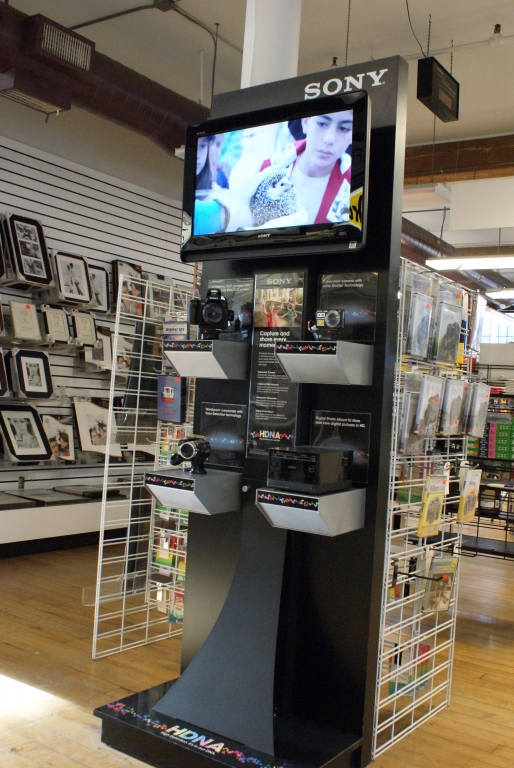Problem Sony sought a “silent salesperson” in specialty camera stores that would promote its digital imaging products and keep them juiced up for live customer demos.
Solution An end-cap display with power-to-product construction combines power with security, while also sharing product features and benefits.
For the 2008 holiday season, Sony wanted its high-definition cameras, camcorders and hard drive photo storage units to be high on shoppers’ Christmas lists. But the economic climate meant nearly all camera retailers had fewer sales associates on hand to handle the holiday shopping crowds. And that meant Sony products might sit inside glass cases, where shoppers could only look at them until someone became available for assistance.
Worse, if there were no power source inside these displays, the products would be “dead” when they did get into shoppers’ hands, limiting the ability to test all of the bells and whistles in the store.
So the electronics retailer developed two merchandising goals: to get its products out from under the glass cases and to show the entire product line together. And, since Sony wanted the products in the new display to be interactive, some form of security had to be added to the list of design requirements.
Natalie Derose, Sony’s retail marketing manager, says the company turned to MDPF Inc., a display company based in Santa Fe Springs, Calif., to create a sleek, black endcap featuring Sony’s signature Alpha 350 and Cyber-shot W170 cameras and a camcorder on individual shelves. Overhead, a high-def LCD screen runs a slide-show presentation demonstrating the media storage unit, which connects digital images directly to a television for interactive slideshows. Graphics running down the center of the display unit share product information and features.
MDPF also worked with Vanguard Product Group (Oldsmar, Fla.) to incorporate a powered system for the four products featured in the display. Each of the electronic devices is connected to its own power coupler, which sends juice to the device while also alarming the product via a built-in security system. An internal cord reel enables shoppers to pick up and play with the merchandise. “Shoppers aren’t going to buy a device without playing with the features,” says Bob Dozois, Vanguard’s regional marketing manager. If the connection in the device mounting is broken, an alarm is triggered.
The unit also enables Sony to unplug products and shift them around for easy remerchandising. And the internal power source means store personnel no longer have to remember to charge the devices each night. “It’s power, protection and promotion, all in one display package,” says Tony Lynas, a display rep for MDPF.
Derose says retailers were eager to have a new store display so “there was no need to negotiate or convince them to use it. We designed only one fixture and they figured out ways to make it work.”
Prior to the holiday season Sony rolled the endcap out to 130 stores and plans to push it out to other specialty store locations in the coming months. “Now,” says Derose, “we don’t need some uninformed or distracted sales associate to give shoppers an idea of our products and their features.”
PHOTOGRAPH: PAUL J. FONTAINE, PROVIDENCE, R.I.


 Photo Gallery2 days ago
Photo Gallery2 days ago
 Headlines1 week ago
Headlines1 week ago
 Headlines2 weeks ago
Headlines2 weeks ago
 Headlines2 weeks ago
Headlines2 weeks ago
 Sector Spotlight2 weeks ago
Sector Spotlight2 weeks ago
 Headlines1 week ago
Headlines1 week ago
 Headlines3 days ago
Headlines3 days ago
 Headlines1 week ago
Headlines1 week ago







